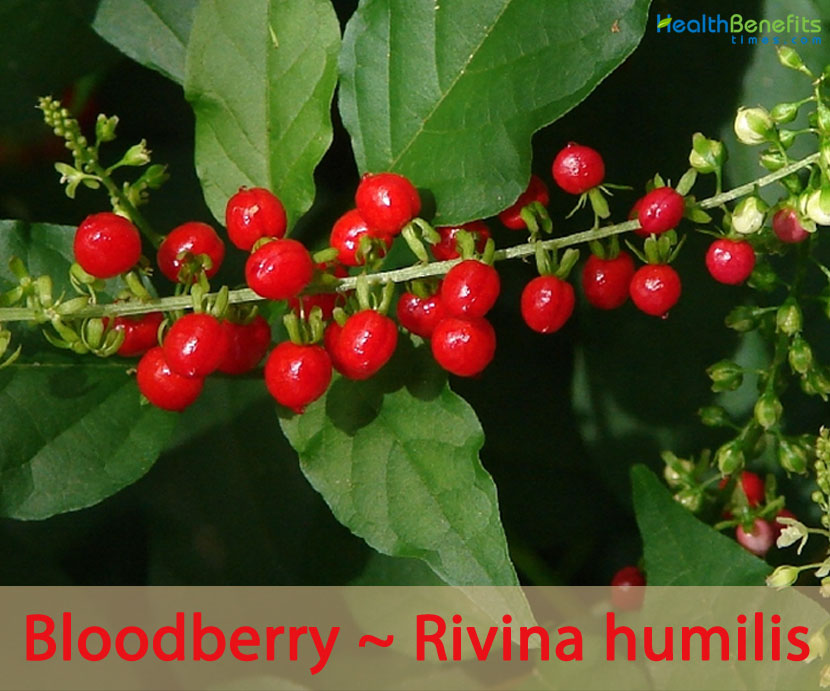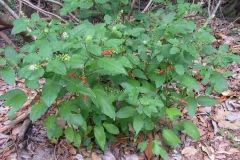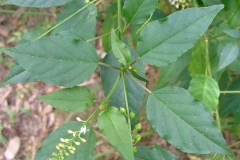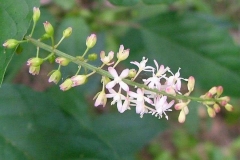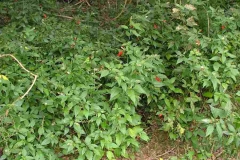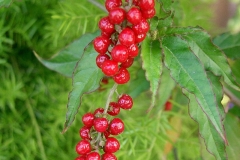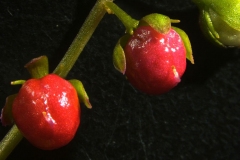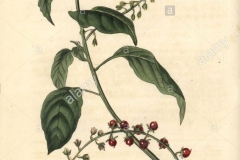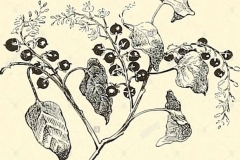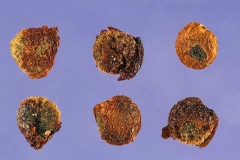| Bloodberry Quick Facts | |
|---|---|
| Name: | Bloodberry |
| Scientific Name: | Rivina humilis |
| Origin | Southern USA , Mexico, Central America , the Caribbean and South America |
| Colors | Initially green turning to bright shining red (occasionally orange) as they mature |
| Shapes | Small glossy, sub-globose berries that contain a single seed. These fruit are 2.5–5 mm (0.098–0.197 in) in diameter. |
| Health benefits | Treat of wounds, bruises and cuts, Treatment of skin conditions, Relieving headache, joint pains and muscle pain, Treatment of infertility, Treatment of gastrointestinal disturbances, Respiratory support |
| Name | Bloodberry |
|---|---|
| Scientific Name | Rivina humilis |
| Native | Southern USA (i.e. Oklahoma, Arkansas, Florida, Louisiana, Mississippi, New Mexico, Texas and Arizona), Mexico, Central America (i.e. Belize, Costa Rica, El Salvador, Guatemala, Honduras, Nicaragua and Panama), the Caribbean and South America (i.e. French Guiana, Guyana, Surinam, Venezuela, Brazil, Bolivia, Colombia, Ecuador, Peru, Argentina and Paraguay). It has been widely introduced to other countries and has become naturalized in much of the Pacific and a small number of countries in Africa and Asia |
| Common Names | Baby pepper, bloodberry, coral berry, pigeon berry, rouge plant, Coralito, Small Pokeweed, Inkberry, turkeyberry, Jumby Pepper, Jumbi Pepper, Slippery Bush, Wild tomato, cat’s blood, dog blood, dogberry, jumbie basil, jumbie pepper |
| Name in Other Languages | Afrikaans: Bloedbessie Australia: Coralberry, turkeyberry Bengali: Byānḍēla phula (ব্যান্ডেল ফুল) Chinese: Sangoju (珊瑚珠), shu zhu shan hu, Juzusango zoku (数珠珊瑚属), shù zhū shān hú shǔ Dutch: Bloedbes English: Bloodberry, Coralberry, Pigeonberry, Rougeplant, Turkeyberry, Jumby Pepper, Jumbi Pepper, Slippery Bush, Wild tomato, baby pepper, cat’s blood, dog blood, dogberry, jumbie basil, jumbie pepper Finnish: Verimarja French: Groseille, petite groseille, dimwazèl, herbe au charpentier, lyann blan, rivinie, zèb blan German: Blutbeere Italian: Erba da legnaioli , Japanese: Juzusango (ジュズサンゴ) Malayalam: Rakthanelli (രക്തനെല്ലി) Portuguese: Rivina, vermelhinha Russian: Rivina nizkaya (ривина низкая) South Africa: Bloedbessie, bloodberry Spanish: Coralito, carmine, achotillo, hierba del carpintero, corallilo Swedish: Sminkbär Tongan: Polo USA: Pigeonberry, turkeyberry |
| Plant Growth Habit | Upright, herbaceous to woody perennial plant or small shrub |
| Growing Climates | Woods, roadsides, in fields, pastures, closed forests, forest margins, thickets, shell middens, hammocks, disturbed areas, river margins, shady areas in grassland, in villages, particularly in dump sites, waste areas, urban bush land and gardens in tropical and sub-tropical regions |
| Plant Size | 0.4–2 m (1.3–6.6 ft.) |
| Stem | Erect, dichotomously branched, angular, glabrous or slightly pubescent at the nodes and softly pubescence when young |
| Leaf | Simple leaves are alternately arranged along the stems with a wavy margin. They are borne on stalks (i.e. petioles) 1-5 cm long. Leaves blades are light green, thin textured, 3-13 cm long and 1-5 cm wide are oblong or narrowly egg-shaped in outline |
| Flower | Numerous small flowers are produced in each of these clusters, each being borne on a short stalk (i.e. pedicel) 1-4 mm long. These flowers have four small ‘petals’ (i.e. perianth segments) 1-3 mm long and four stamens |
| Fruit Shape & Size | Small glossy, sub-globose berries that contain a single seed. These fruit are 2.5–5 mm (0.098–0.197 in) in diameter |
| Fruit Color | Initially green turning to bright shining red (occasionally orange) as they mature |
| Seed | Seed lenticular, hard, 2.5-3.5 mm in diameter, puberulent |
| Propagation | By Seed and cuttings |
| Plant Parts Used | Fruits |
| Health Benefits |
|
| Other Facts |
|
Plant Description
Bloodberry is an upright, herbaceous to woody perennial plant or small shrub that normally grows about 0.4–2 m (1.3–6.6 ft) tall. The plant is found growing in woods, roadsides, in fields, pastures, closed forests, forest margins, thickets, shell middens, hammocks, disturbed areas, river margins, shady areas in grassland, in villages, particularly in dump sites, waste areas, urban bush land and gardens in tropical and sub-tropical regions. The plant has woody taproot and stem is erect, dichotomously branched, angular, glabrous or slightly pubescent at the nodes. Younger stems are greenish in color and mostly hairless (i.e. glabrous).
Leaves
The simple leaves are alternately arranged along the stems with a wavy margin. They are borne on stalks (i.e. petioles) 1-5 cm long. Leaves blades are light green, thin textured, 3-13 cm long and 1-5 cm wide are oblong or narrowly egg-shaped in outline (i.e. narrowly-ovate) with entire margins and pointed tips. They are hairless or sparsely hairy. The base is round and the apex is acuminate. Upper leaf surface is glabrous and lower surface is covered with few minute hairs along midrib and main veins.
Flowers
The whitish flowers are arranged in elongated clusters that are 4-8 cm long, lengthening to 5-15 cm long in fruit) in the forks of the upper leaves. Numerous small flowers are produced in each of these clusters, each being borne on a short stalk (i.e. pedicel) 1-4 mm long. These flowers have four small ‘petals’ (i.e. perianth segments) 1-3 mm long and four stamens. The ‘petals’ are initially white or pinkish but turn greenish as they mature. Flowering occurs mostly during spring and summer.
Fruit
The fruit are small glossy, sub-globose berries that contain a single seed. These fruit are 2.5–5 mm (0.098–0.197 in) in diameter and are initially green turning to bright shining red (occasionally orange) as they mature. The rounded seeds are 2.5-3.5 mm across.
Health benefits of Bloodberry
Listed below are some of the popular health benefits of blood berry
1. Treat of wounds, bruises and cuts
Every day, a lot of people across the globe sustain cuts and wounds from different activities and sometimes these wounds turn to be chronic due to infections and several other reasons. Though, the tea from the leaves of the Bloodberry has been found effective in speeding up the healing process of wounds, cuts and bruises and it helps in preventing infections that would lead to additional complications. If you have sustained a cut, all you need to do is make some tea from Bloodberry leaves and uses it to wash he wound three times a day until healing occurs.
2. Treatment of skin conditions
Skin infections are very common since it is always exposed to different stimuli that predispose it to infections. Occasionally treating these infections is a chill wind but with the Bloodberry tea you can easily treat your skin. All you need to do is to prepare tea from the leaves of this plant and use it to bath.
3. Relieving headache, joint pains and muscle pain
Bloodberry tea has been effectively used in treating pain and headaches. It contains compounds that show strong anti-inflammatory activity that is responsible for pain and headaches.
4. Treatment of infertility
There are several causes of infertility in women and Bloodberry can correct infertility caused by obstruction of the fallopian tubes. Decoction from Bloodberry helps in clearing the fallopian tubes enhancing the easy fertilization of the ovum.
5. Treatment of gastrointestinal disturbances
Tea from the Bloodberry is effective in correcting gastrointestinal disturbances and it enhances the normal peristalsis and movement of the gut contents.
6. Respiratory support
Bloodberry is also used to resolve several respiratory complaints, especially in the treatment of catarrh, also coughs, colds, and fever.
Traditional uses and benefits of Bloodberry
- It has been used as a folk medicine to treat colds, diarrhea, difficult urination, flatulence, gonorrhea, jaundice and ovarian pain.
- Leaves are said to be used for catarrh and for treating wounds.
- It may be used to treat wounds, bruises and cuts.
- Tea from the leaves is used to wash the wounds, bruises and cuts and any other skin ailments.
- Tea may also be used as herbal bath and this can also treat the skin ailments as well.
- It is useful for headaches, muscle and joint pains; it relieves gastrointestinal problems and is widely believed to be effective in treating infertility problems by clearing the Fallopian tubes of blockages.
- It is also great for menstrual problems, especially cramps.
- It is widely used to resolve womb-related conditions such as infertility, irregular periods, painful periods, fibroids and cysts.
Precautions
- Consumption of the fruit produces numbness of the mouth, within 2 hours with a feeling of warmth in the throat and stomach.
- This is followed by coughing, thirst, tiredness with yawning, and subsequent vomiting and diarrhea.
References:
https://www.itis.gov/servlet/SingleRpt/SingleRpt?search_topic=TSN&search_value=19534#null
http://www.hear.org/pier/species/rivina_humilis.htm
https://www.cabi.org/isc/datasheet/116742
http://www.missouribotanicalgarden.org/PlantFinder/PlantFinderDetails.aspx?kempercode=m220
https://indiabiodiversity.org/species/show/230967
http://www.theplantlist.org/tpl/record/kew-2425661
https://en.wikipedia.org/wiki/Rivina_humilis
https://keyserver.lucidcentral.org/weeds/data/media/Html/rivina_humilis.htm
https://plants.usda.gov/home/plantProfile?symbol=rihu2
http://tropical.theferns.info/viewtropical.php?id=Rivina+humilis
http://www.flowersofindia.net/catalog/slides/Blood%20Berry.html
https://gd.eppo.int/taxon/RIVHU


